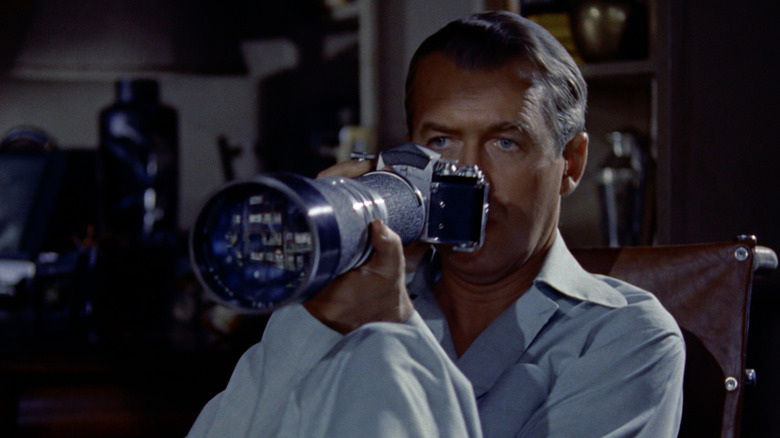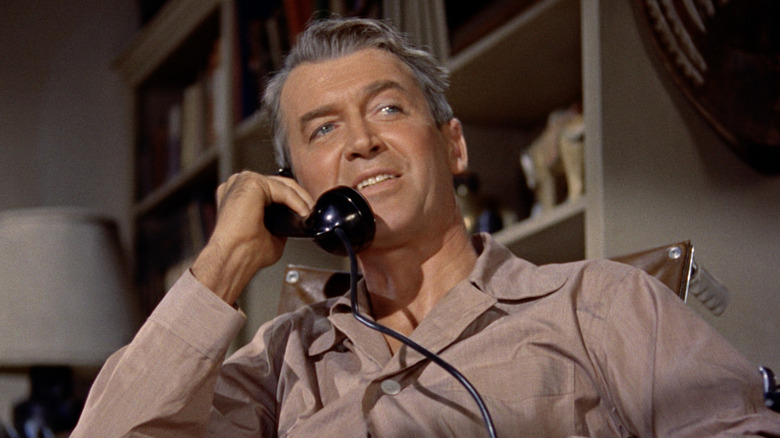Alfred Hitchcock Used A Simple Trick To Make Rear Window's Premise Work
We may receive a commission on purchases made from links.
When I first started taking classes on filmmaking, one of the first principles of editing you learn is the Kuleshov effect. Over 100 years ago now, Russian filmmaker Lev Kuleshov created a short film demonstrating the power of editing through juxtaposition. The film starts with a shot of a bowl of soup and cuts to a close-up of Russian actor Ivan Mosjoukine, indicating he is hungry. Next, we see a little girl lying in a coffin, followed by another shot of Mosjoukine to show his sadness. Finally, there is a woman lounging on a divan, cutting to Mosjoukine to see his lust. Surprisingly, the shot of Ivan Mosjoukine is the exact same all three times. When this film was first shown to audiences, everyone was convinced Mosjoukine's expression changed to convey a specific emotion, but that was not the case. Kuleshov figured out that by placing two unrelated images together, the audience will fill in the gaps between them on their own. He can just show a man looking at something, and we can determine his emotional response to that thing.
Cinema is all about looking. If two people on screen look at each other, we can tell they are in love, and if one quickly turns their head to stop looking, we can tell they are afraid of the other. Most importantly, we are voyeurs to the lives of the people in the film, observing them even in their most intimate moments. Nobody understood the many layers of looking more than Alfred Hitchcock, and no film exemplifies this better than "Rear Window," a film built entirely on voyeurism. While a film set in one room with a guy looking out his window may be daunting to some, Hitchcock turned to Kuleshov to make something that could only be cinema.
Looking and reacting
When most directors make a film that basically takes place in one location, the outside world gets entirely cut off. The film becomes about the isolation, the enclosed space. For Alfred Hitchcock, he saw this limitation as a chance to return to the foundations that the medium was built on.
During his series of interviews with legendary French filmmaker François Truffaut compiled into the book "Hitchcock," the Master of Suspense spoke about how "Rear Window" built upon the principles Kuleshov explained for Hitchcock's own prurient purposes:
"It was a possibility of doing a purely cinematic film. You have an immobilized man looking out. That's one part of the film. The second part shows what he sees and the third part shows how he reacts. This is actually the purest expression of a cinematic idea ... [L]et's take a close-up of Stewart looking out of the window at a little dog that's being lowered in a basket. Back to Stewart, who has a kindly smile. But if in the place of the little dog you show a half-naked girl exercising in front of her open window, and you go back to a smiling Stewart again, this time he's seen as a dirty old man!"
Through this looking and reacting, we come to understand who James Stewart's L.B. Jeffries is and thus come to empathize with him, having us experience the titillation and terror he does.
Truffaut believes, "We're all voyeurs to some extent," and Hitchcock firmly agrees. I wouldn't go as far to say everyone is pervert, like David Fincher does, but shirking our curiosity is immensely difficult, even when we know it's wrong. Cinema lets us indulge in it briefly without repercussions, and "Rear Window" does it better than anything just through simple classical filmmaking techniques.

